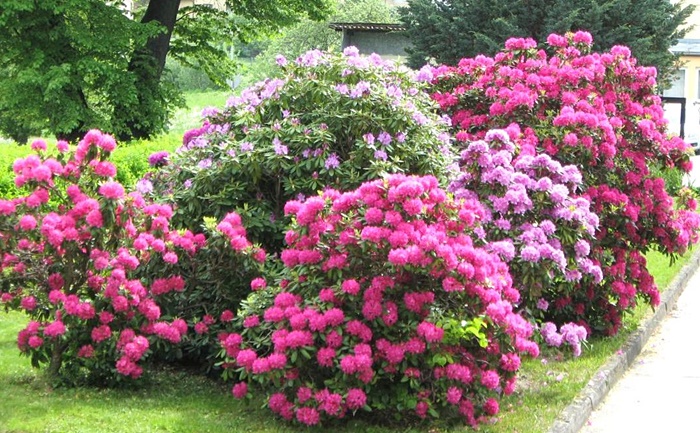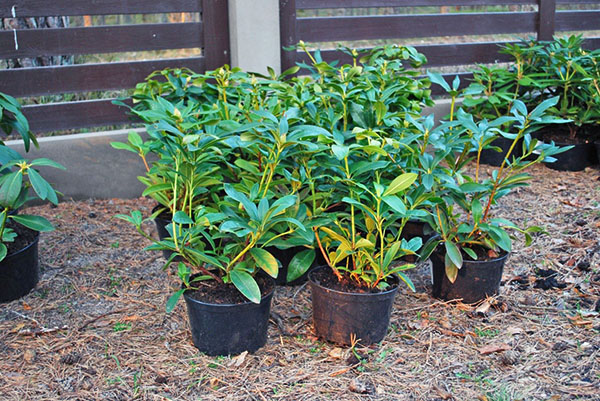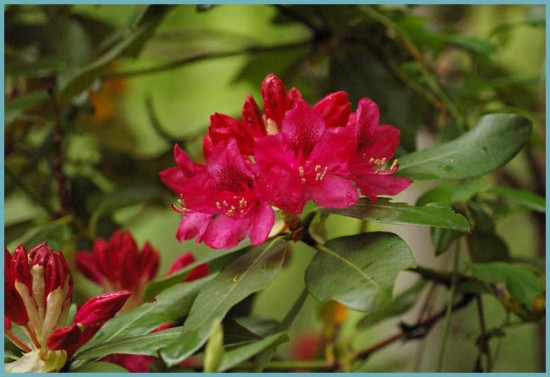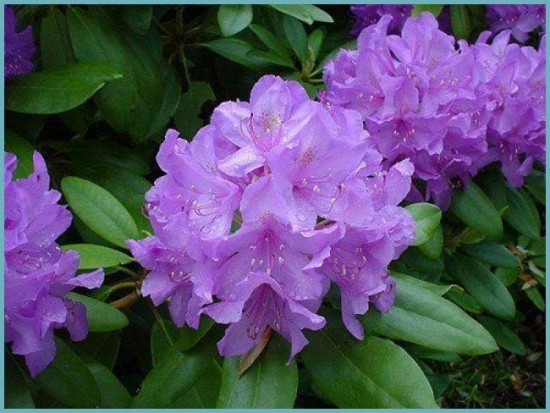The main stages of planting rhododendron in spring
Planting a garden rhododendron outdoors in spring consists of several key steps. To do everything correctly and competently, it is enough to follow all the rules and perform every step with high quality.
Choosing a place and soil for planting
Where is the best place to plant a shrub on your site? The following recommendations will help you choose the ideal place for planting and growing rhododendron in the open field:
- The plant will be most comfortable in partial shade. Ideally, if the shrub will be under diffused sunlight during the day, and at noon will be protected from the most active scorching rays, for example, when grown near a tree with a wide crown. By the way, deciduous rhododendron needs more sunlight (especially Kamchatka, Daurian, Canadian).
- The site must be protected from wind and drafts, but there must be normal air circulation.
- The crop prefers acidic soils (pH 4-4.5).
- The soil should not be too heavy clayey or too light, sandy.
- Choose a location that maintains moderate humidity without waterlogging or drying out quickly.
- This crop has a shallow root system, so do not plant rhododendrons next to neighbors in the garden, which also have a shallow root system (otherwise, competition for nutrients in the soil cannot be avoided).
Site and pit preparation
As mentioned above, rhododendrons prefer acidic soils, so it is very important to properly prepare the planting hole so that the shrub is comfortable and pleases you with its beautiful flowering. So, you need to prepare the pit as follows:
So, you need to prepare the pit as follows:
- Dig a hole, its size should be 3 times larger than the root system of the seedling. On average, the depth is about 60-80 centimeters, and the width is about 70 centimeters.
- If your site has heavy clay soil, then you need to put a drainage layer on the bottom (about 10-15 centimeters thick). You can use, for example, crushed stone, broken brick, expanded clay, pebbles.
- The planting hole should now be filled with suitable soil. The dressing can be prepared according to one of the following recipes:
- Sour high-moor peat and pine litter are mixed in equal proportions.
- Sour high-moor peat (3 parts) + pine bark (1 part) + garden soil (0.5 parts).
- Horse sour peat (3 parts) and rotted compost (1 part).
- If you do not have the ingredients listed above, you can use a special soil for azaleas (you can buy it at the garden center).
- Fill the hole 1/2 full and mix well.
Direct planting of rhododendron
So, you have prepared the place and the hole, it's time to start the spring planting of a garden rhododendron seedling in open ground, it is recommended to act according to the following scheme:
- If you are planting a seedling with a closed root system (container type), then you just need to carefully remove it from the container and, without destroying the earthen lump (just gut it slightly), plant it in a new place by transshipment.
- If you have a seedling with an open root system, then you need to make a small mound in the center of the hole, put a seedling on it, spread the roots so that they do not bend and lie flat. Water so the roots spread out better.
- You need to plant it to such a depth that the root collar (the place of transition from the trunk to the root) is slightly above ground level. Do not under any circumstances deepen it.
- Then you need to fill the planting hole with the seedling with the soil mixture that you originally used to fill the hole.
- Lightly shake the stem of the seedling to eliminate possible voids in the roots.
- Lightly compact the soil around the seedling.
- Water abundantly.
- Mulch the trunk circle. It is advisable to use pine litter or bark as a mulching material, because they acidify the soil. But you can also mulch with rotted sawdust, peat. The thickness of the mulch is about 10 centimeters.
Reproduction methods
In the Urals, rhododendron can be propagated in one of three ways. Which method to choose depends on its variety. Since there are varieties that are easily propagated by cuttings, other varieties can be grown from seeds.
Seed reproduction
This is the longest and most difficult way. Get ready to see the first flowering in at least eight years.
- The seeds of the desired variety are purchased from the store. It is undesirable to buy them from hands, otherwise a completely different plant will grow. And all the work will be wasted.
- Prepare a small pot.
- Fill it with peat and sand (3: 1).
- Moisten the soil well.
- Sow the seeds at least 3 centimeters apart.
- Cover these seeds with sand.
- For a microclimate, cover the pot with plastic wrap.
- Place the pot in a bright place, but not in direct sunlight.
- Open the plastic wrap for a few minutes every day for a month and moisten the soil as needed.
- If everything is done correctly, then in 30 days the first shoots will hatch.
- As soon as more than 3 true leaves grow on the sprouts, they are transplanted into separate pots.
- They can be transplanted to open soil only after two years, when they are sufficiently strong.
Cuttings
This method is somewhat easier than seed.
- This breeding method is carried out only in early spring, before the first buds appear.
- A suitable woody shoot is looked after on a suitable mother bush.
- A stalk about 10 centimeters long is cut from it.
- Its lower part is cut off from the branches, placed in a solution for 24 hours, which accelerates the growth of roots.
- A small pot is filled with peat and sand (3: 1).
- The stalk is rooted in the middle of the pot.
- Cover the top with a jar or cut-necked plastic bottle.
- Further, depending on the type of plant, root formation is expected.
- After the roots have grown, in the fall or late summer, the cutting is transplanted into a large pot of peat and pine needles.
- For the winter, the pot with it is moved to a cool place, where the temperature is kept at 12 ° C.
- In the spring, it is planted in open soil. If this place is not quite suitable for the bush, then it can be transplanted to a permanent place after two years. It is undesirable to transplant it anymore.
Reproduction by layering
Even a beginner can handle this method.
- Reproduction by layering is carried out in the spring immediately after the snow has melted and the last frosts have passed. Since the ground must be warm and soft.
- Then choose the lowest shoot and bend it to the ground. It is desirable that this shoot be young and flexible.
- A small incision is made in the bark of this shoot.
- This shoot is fixed to the ground with a large and strong hairpin, which can be made from wire.
- This part of the shoot is buried in peat so that the top with the buds is above the ground.
- Water everything well.
- This layer can be cut off from the bush only after a year, when it has already taken root.
Properties of rhododendron
In addition to the indisputable decorative advantages, rhododendron has medicinal properties that are widely used in folk and traditional medicine. Species such as Rhododendron Daurian, Golden, Adams, Caucasian, contain andromedotoxin, ericolin, arbutin and rhododendrin. The leaves of rhododendron also contain ascorbic acid, the highest concentration of which in the plant is observed in the summer months.Due to the content of substances useful for the human body, rhododendron has antipyretic, analgesic, bactericidal, sedative and diaphoretic effects. It removes excess fluid from the body, relieving shortness of breath, edema, rapid heartbeat, lowers arterial and venous pressure and enhances cardiac activity.
However, rhododendron is far from harmless. During pregnancy and breastfeeding, as well as patients with tissue necrosis and suffering from serious kidney disease, you should refrain from taking drugs based on rhododendron. And in any case, before taking such medications, it would be most correct to first consult with doctors.
Now let's find out what are the features when growing rhododendrons in the garden of Siberia.
Climatic conditions

When choosing a variety for cultivation, you should always take into account the climate of your area - it should correspond as much as possible to the usual conditions of natural plant germination.
The sharply continental climate of central Siberia is well suited for growing the above frost-resistant varieties of rhododendron, although this plant is considered more thermophilic.
Soil type
Rhododendron bushes love to grow in loose soil with high acidity. To give the soil the desired composition, add peat to it, mixed with sand, fractional pine bark and needles.
In order to prevent the roots of shrubs from rotting in swampy soil, a prerequisite will be the presence of drainage at the bottom of the planting holes, with a layer of 20 centimeters.
Planting rhododendron in Siberia
The process of growing rhododendron, caring for it and reproduction of this shrub in the climate of Siberia requires some nuances, which we will now consider.
Timing
Spring is perfect for planting the above frost-resistant varieties. It is in the spring that all systems of this plant are activated, which will allow it to painlessly transfer this process and thoroughly root in a new place. If your shrub has closed roots, you can plant it later.

When choosing the right planting material, the following factors should be considered:
- External signs of health. This refers to the green color of the leaves, without brown and yellow blotches and spots, as well as the strength and elasticity of the branches and shoots of the shrub.
The small size of the bush. It is better if it is in a state of flowering.
The presence of a pot. It is better to buy a rhododendron with a protected root system. If thin bush roots stick out from the back of the pot, then it grew in this particular flowerpot and was not transplanted before being sold.
The number of leaves. They should grow densely, covering almost the entire surface of the branches, forming a lush crown. Rare foliage indicates that the greens are falling off, which means that the plant is weak.
Scheme and technology
Planting rhododendron is best in a semi-shaded area, protected from direct sunlight and strong winds. The landing hole is dug about half a meter deep and up to 70 cm wide.
Do not forget that in order to avoid decay, the seedlings should not be deeply deepened into the ground, since the plant has a superficial root system. Immediately after planting, the bushes need to be watered and mulched.
For this, needles or crushed pine bark are best suited. This technique will work as an obstacle to the evaporation of vital moisture, protect the roots from overheating in summer and from cold in winter, and also maintain the required level of acidity in the soil.
Choosing a landing site
4 conditions are important here: no stagnation of water; good wind protection; air humidity; shading.
- Rhododendrons are moisture-loving, but they get sick from its stagnation in the soil. Therefore, the landing site is drained. Expanded clay, broken brick or gravel are poured at the bottom of the planting pit, and a high bed is made (10-15 cm above the flood water level). The bed is covered with a stone, making sure that during the spring thaw, the root collar of the plant does not get wet.
- The wind, especially in winter, dries the plants. Shrubs should be planted near the walls of buildings, along the hedges, under the protection of conifers.
- The best option for ensuring air humidity is planting near a reservoir, if this is not possible, it is useful to spray the shrub in hot weather.
- The main point in determining a place is protection from the sun, its direct rays.
Rhododendrons are planted on the north side of a hedge or residential building, or in the shade of trees so that the plants are not oppressed during the midday period.
Conifers and oak are optimal neighbors. Their roots go deep and do not interfere with shrubs with a small superficial root to receive food and moisture from the soil.
An acceptable option is planting next to fruit trees.
Linden, aspen, chestnut, birch, maple, poplar have superficial roots, like rhododendron, they deplete the soil, prevent the plant from eating normally.
The spring sun is also dangerous for shrubs: in early spring, the buds on plants under direct rays lose moisture, and leaves are burnt on evergreen species. They must be protected with shields from the south and west.
So, the choice of a planting site is the maximum approximation to the conditions of natural habitation of this heather plant.
Varieties and varieties
Translated from Greek, rhododendron sounds like "rosewood". The Rhododendron Park in Bremen, in northern Germany, is a real paradise for fans of these colorful shrubs. There is an unmatched collection of 600 wild species of 3,250 cultivars of these plants. Unfortunately, only a few of them are suitable for growing in central Russia and the Urals. In Russia, there are 18 plant species in their natural environment.
 There are many varieties of rhododendron that can be grown in the Urals
There are many varieties of rhododendron that can be grown in the Urals
Rhododenrons can be divided into several groups:
- deciduous;
- evergreen;
- semi-evergreen.
When choosing a variety for planting in the Urals, pay attention to winter hardiness - the plant must withstand a drop in temperature to 32 degrees without shelter. The rest is a matter of taste
We recommend for planting such time-tested varieties as in the photo:
Nova Zembla.
 Variety Nova Zembla
Variety Nova Zembla
Katevbinsky Grandiflorum.
 Variety Katevbinsky Grandiflorum
Variety Katevbinsky Grandiflorum
Roseum Elegance.
 Roseum Elegance variety
Roseum Elegance variety



